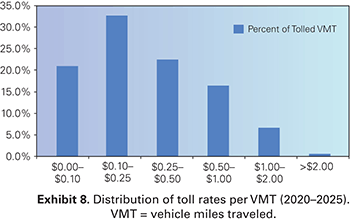Economics: Pricing, Demand, and Economic Efficiency—A Primer
Empirical Estimates of Congestion Tolls
Because congestion pricing is still a relatively new approach for managing congestion, especially in the United States, and has yet to be implemented comprehensively in its “pure” form, empirical estimates of the magnitude of optimal congestion tolls are limited. However, the results from two separate studies of potential congestion-pricing applications have yielded interesting insights into the potential of congestion pricing.

Graph. Exhibit 8: Distribution of toll rates per vehicle mile traveled (VMT; 2020–2025). Source: Report of the National Surface Transportation Revenue and Policy Study Commission, Volume III, Paper 6C-04, January 2008. The bars on the graph represent the percentage of tolled VMT. The graph shows that approximately 20.0% of tolled VMT cost $0.00–$0.10, approximately 33.0% of tolled VMT cost $0.10–$0.25, approximately 22.5% of tolled VMT cost $0.25–$0.50, approximately 17.5% of tolled VMT cost $0.50-$1.00, approximately 7.5% of tolled VMT cost $1.00–$2.00, and approximately 0.5% of tolled VMT cost >$2.00.
Source: Report of the National Surface Transportation Revenue and Policy Study Commission, Volume III, Paper 6C-04, January 2008.
An analysis of future highway investment and performance that used FHWA’s Highway Economic Requirements System (HERS) examined the potential impacts of implementing efficient pricing on all congested roads after 2020. The estimated congestion tolls averaged 34 cents per vehicle mile (in 2006 dollars) on roads where it was “implemented” in the analysis, which were predominantly located in major urbanized areas. Over 50 percent of the vehicle miles subject to congestion pricing in the scenario had estimated toll rates below 25 cents per mile, whereas approximately 7 percent had toll rates over $1.00 per mile (see Exhibit 8).
By using a grant from the Value Pricing Pilot Program, the Puget Sound Regional Council in
Seattle recently completed a study(1) of the impact that congestion-based tolling could have on travel behavior. The project involved 275 households whose vehicles were equipped with GPS-based tolling meters. Participants were subjected to a per-mile toll schedule on major arterials in the region that varied significantly based on the time of day (with charges up to 50 cents per mile in the weekday afternoon peak) and the location of travel (with higher rates applied on freeways). The study found that households made several modifications to their travel patterns in response to the congestion tolls, including reductions in the number and length of trips, choosing alternate routes and travel times, and switching to transit. On the basis of the results of the pilot program, the study estimated that a full-scale implementation of congestion pricing on the area’s road network could yield over $28 billion in net benefits.